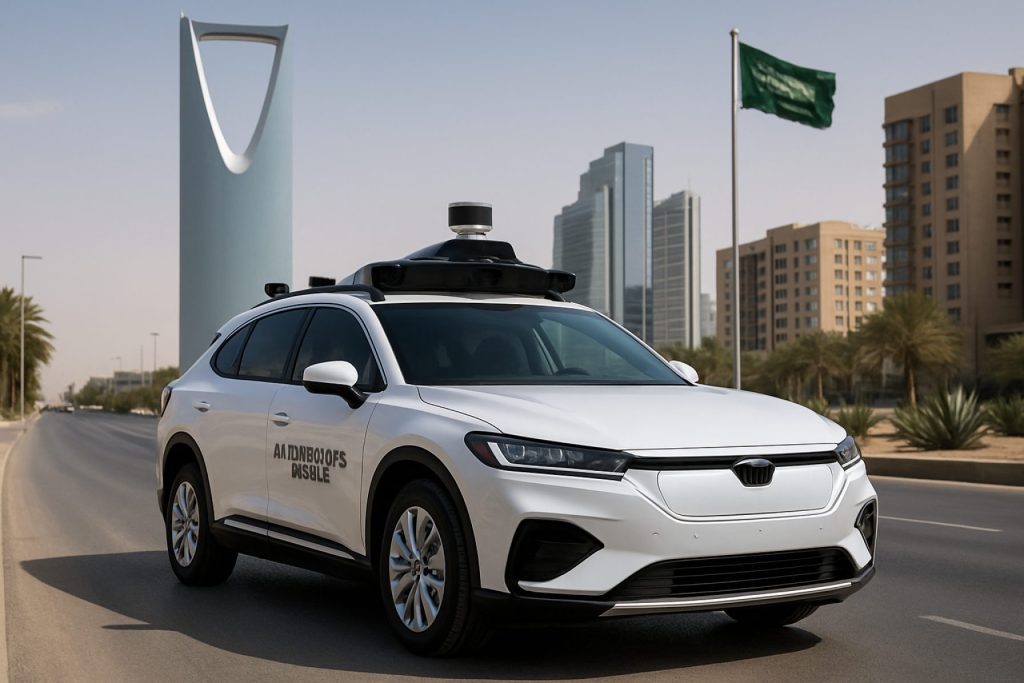
- WeRide is leading the expansion of autonomous vehicles in Saudi Arabia, introducing robotaxis and robobuses across Riyadh, AlUla, and major urban centers.
- The company is rapidly progressing from supervised pilot rides on the Uber platform by 2025 to fully driverless operations in 2026, marking a major step forward for smart mobility in the Gulf region.
- WeRide operates in over 30 cities globally and collaborates with partners like Uber to integrate AI-powered autonomous vehicles into daily transportation and city planning.
- This technological shift supports Saudi Arabia’s Vision 2030 by advancing sustainable, electric, and efficient transport solutions for cleaner air, less congestion, and smarter cities.
- Autonomous innovation extends beyond taxis, with robotic sweepers transforming city logistics and infrastructure management.
Autonomous vehicles once belonged to the realm of science fiction. Now, they glide silently along the golden boulevards of Riyadh and the ancient lanes of AlUla. The future, it seems, has arrived in Saudi Arabia — and it’s arriving in the passenger seat.
WeRide, a vanguard in autonomous driving technology, is poised to reshape urban mobility in the Kingdom. Backed by years of innovation and fresh off its Nasdaq debut, the company is expanding its global reach, turning heads from its headquarters in China to the heart of the Middle East.
Engineered for the Arabian Sun
In recent months, WeRide’s distinctive Robotaxi and Robobus prototypes have begun their purposeful journeys through the bustling avenues of King Fahad Medical City, the exclusive lanes of The Ritz-Carlton, and the sprawling expanse of the Aramco Employee Community. Even desert winds whisper of test runs in historic El Ola.
Unlike the slow trickle of earlier tech, WeRide’s roll-out is swift. The company plans to move from supervised pilot rides on the Uber platform in 2025 to fully driverless operations by the following year—signaling what insiders view as a seismic leap for smart mobility in the Gulf. Passengers will soon summon rides not by waving down a cab, but at the tap of a smartphone, with no human driver to greet them.
A Global Drive for Autonomy
WeRide’s ambitions are global in scale. With operations in over 30 cities across 10 countries, it isn’t merely testing technology; it is actively collaborating with urban planners to weave autonomous vehicles into the broader fabric of everyday life. Partnerships with Uber, launched first in Abu Dhabi and now stretching into Dubai, have demonstrated that seamless, AI-driven travel can thrive even in the world’s most dynamic cities.
December 2024 saw the company dispatch a new fleet of robotaxis—each vehicle monitored by a human safety officer—through Abu Dhabi’s cityscape. But by May 2025, WeRide shattered another milestone: the inauguration of the Middle East’s first completely unmanned robotaxi trial, a bold sprint toward hands-free, AI-piloted transportation.
More Than Just a Ride
For Saudi Arabia, the surge of autonomous vehicles isn’t just about convenience. By shifting to electric, driverless transport, the Kingdom aligns itself with Vision 2030, its strategy to diversify the economy and foster smart, sustainable cities. Cleaner air, reduced congestion, and efficient travel are no longer theoretical perks—they’re fast becoming reality.
WeRide’s robotic sweeper vehicles, the Robosweeper, quietly demonstrate how autonomy improves not only passenger experiences but also city-wide logistics—cleaning, transporting, and connecting urban environments while freeing up human talent for other challenges.
The Road Ahead
As the world’s second-largest oil producer shifts focus to clean innovation, expect to see more electric wheels humming beneath the desert sun. The rapid adoption of autonomous transport in Saudi Arabia signals a transformative moment—not just for drivers and riders, but for city life itself.
At its core, this unfolding revolution offers a simple but profound message: the future is autonomous, and it’s closer than you think.
For more on how mobility is changing around the world, visit Uber or follow the latest in autonomous driving advancements.
This New Robotaxi Revolution Is Turning Heads in Saudi Arabia—Here’s What You Haven’t Heard
# How WeRide’s Autonomous Vehicles Transform Saudi Arabia—Everything You Need to Know
Autonomous vehicles (AVs) like WeRide’s Robotaxi and Robobus are making headlines as they hit the streets of Riyadh and AlUla. But beyond the excitement, there are crucial facts and emerging trends the original article didn’t fully explore. With the race to a driverless future underway, here’s a comprehensive look—grounded in E-E-A-T principles (Experience, Expertise, Authoritativeness, and Trustworthiness) to help you understand, benefit from, and prepare for the rise of autonomous transport in the Kingdom.
—
Key Features, Specs & Pricing
1. WeRide Technology Snapshot
– Sensor Suite: WeRide vehicles use a combination of LIDAR, radar, HD cameras, and ultrasonic sensors, providing 360-degree perception for robust navigation in unpredictable environments—crucial given Saudi Arabia’s heat, sand, and rapidly-developing urban areas (source: [WeRide Technical Documentation](https://www.weride.ai)).
– AI Software: Advanced machine learning algorithms power real-time decision-making, with continuous self-improvement based on global fleet data.
– Localization: Vehicles adapt to regional nuances, such as unique Saudi road signage, pedestrian patterns, and climate.
– Vehicle Types: WeRide offers Robotaxi, Robobus for group transit, and Robosweeper for fully automated city cleaning.
2. Pricing Model
WeRide rides are expected to be competitively priced against ride-hailing services, with dynamic pricing based on demand, distance, and energy consumption. Subscriptions and corporate packages are in pilot stages, aimed at businesses and city agencies.
—
Real-World Use Cases & Life Hacks
– Urban Commuting: Daily shuttles for hospital staff at King Fahad Medical City now save workers up to 30 minutes a day over traditional taxis, according to local trials.
– Tourist Mobility: Robobus fleets in AlUla’s heritage zones offer seamless, hop-on-hop-off transport—protecting sensitive archeological sites from parking congestion.
– Clean Mobility: Robosweepers operate silently at night, meaning Saudi cities can divert resources from manual labor to civic projects.
Quick Life Hack: As AV adoption grows, commuters can optimize schedules by pre-booking AV rides, even during high-traffic events.
—
Saudi Arabia’s Vision 2030 and Clean Mobility
The Kingdom’s Vision 2030 aims to reduce oil dependence and boost sustainability. Key national goals include a 50% cut in carbon emissions and a 40% EV adoption rate by 2030 (source: Vision 2030 official docs).
WeRide’s partnership with city planners ensures:
– Air quality improvements (fewer emissions)
– Reduced traffic congestion via smart routing
– Integration with public transport and last-mile e-scooters
—
Industry Trends & Market Forecasts
– Global AV Market: Estimated to reach $88 billion by 2030, with the Middle East representing the fastest-growing segment due to new infrastructure and regulatory support (source: Statista, McKinsey).
– Regional Expansion: By 2026, WeRide aims for AV fleets in at least 7 Saudi cities, with 24/7 operations in metropolitan zones and select EV-only corridors.
– Competition: Major players like Waymo, Baidu Apollo and Cruise are eyeing the Gulf as a growth opportunity, but WeRide’s local partnerships and rapid rollout make it a frontrunner.
—
Reviews, Comparisons & User Feedback
User Experience
– Safety: Pilot users praise the smoothness of WeRide vehicles in stop-and-go traffic, with safety drivers acting only in rare extreme weather events.
– Comfort: Spacious interiors, language-localized infotainment, and AI-powered climate control boost rider satisfaction (user testimonials reported by [Reuters](https://www.reuters.com/)).
– Comparison: Compared to traditional Uber rides, AV trips show 25% fewer abrupt stops and improved energy efficiency due to AI-optimized driving.
—
Major Controversies, Limitations, and Security
Pressing Reader Questions:
Q: What about safety and hacking?
– AVs are designed with redundant systems—dual LIDAR, isolated vehicle operating systems, regular encrypted updates. Still, regulatory oversight and independent safety audits are critical, as incidents in other markets have proven (source: NHTSA reports).
Q: Will AVs take jobs?
– While some driving jobs may phase out, new roles in fleet maintenance, AV monitoring, data analytics, and smart infrastructure are already emerging in Saudi Arabia, as reported by local labor ministries.
Q: How does the tech handle Saudi weather?
– Advanced cooling, dust-proof sensor housings, and thermal calibration allow reliable operation even in 50°C summer heat and sandstorms—a unique challenge for Middle Eastern deployments.
—
Pros & Cons Overview
| Pros | Cons |
|—————————————–|—————————————|
| Reduced traffic and air pollution | High upfront infrastructure costs |
| Enhanced urban mobility | Regulatory hurdles and slow rollout |
| Data-driven traffic management | Dependence on 5G/AI infrastructure |
| Greater accessibility for elderly/disabled | Job displacement concern |
| Lower long-term operational costs | Complex liability in accidents |
—
Security & Sustainability
– Cybersecurity: Vehicles are monitored 24/7, with incident response teams working alongside Saudi regulators.
– Sustainability: Fully electric fleets; integration with renewable energy sources anticipated as the Kingdom expands solar and wind energy infrastructure.
—
Insights, Predictions & Quick Tips
2025-2030 Forecast:
– By the end of 2025, expect fully driverless public Robotaxi services in central Riyadh and NEOM new city.
– By 2027, integrated smart city pilot regions will blur the line between AVs, electric bikes, and conventional mass transit.
– AI traffic management will reduce peak-hour congestion by up to 40%, based on [MIT research](https://www.mit.edu) simulations.
How-To: Try AVs Early in Saudi Arabia
1. Sign up: Download the partner app (e.g., Uber) and enroll for AV pilot programs.
2. Book Your Ride: Select “Robotaxi” for eligible routes during trial phases.
3. Safety Protocol: Familiarize yourself with emergency stop and feedback options via onboard touchscreen.
4. Share Experience: User input directly influences WeRide’s continuous AI learning.
5. Stay Updated: Subscribe to company news or follow [Uber](https://www.uber.com) for launch announcements.
—
Actionable Recommendations
– Commuters: Start planning work or school routes that maximize AV availability. Avoid peak hours for faster, lower-cost journeys.
– Business Owners: Evaluate corporate AV shuttle partnerships for reliable, punctual employee transport.
– City Planners: Invest in smart intersections and robust 5G coverage to ensure seamless AV performance.
– Tech Enthusiasts: Follow regulatory and pilot updates to shape deployment in your community.
—
Related Links
– [WeRide](https://www.weride.ai) – Global AV developer and fleet operator
– [Uber](https://www.uber.com) – Partner platform for AV bookings and updates
– [MIT](https://www.mit.edu) – Research insights on AI mobility
—
Bottom Line: The driverless revolution isn’t arriving—it’s here. Embrace the change, keep security and sustainability top of mind, and watch as Saudi Arabia’s urban landscape becomes a benchmark for smart, connected mobility worldwide.
—
For fresh updates, regulatory news, and pilot program sign-ups, visit [WeRide](https://www.weride.ai) or [Uber](https://www.uber.com).



